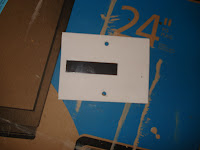With a little trial and error I created a pattern in my head and now I have a cute cover. I'll explain the process I used and the better way to do it as I go along.
Defacing a Book! The first step is to get an old book. I went through my pile of yard sale books and held my Nook up to each one to see which would fit the best. I can't believe I tore a book apart. Seems sacrilegious or something. I then used a utility knife and took the pages and binding out of the book cover.
Now I got all technical and doubled my fabric over and placed the book on top of the fabric. I measured so that I had enough fabric for 1/2" seam allowance on the top and bottom of the book and one side. I left a little extra on one of the sides for wiggle room. Set this aside and cut two pieces of low loft batting to the size of the book. Also cut a piece of interfacing on the inside for more stability.
Now take your fabric and sew three sides together. Turn it inside out and stick the book inside to check on your fit. When you are satisfied put your book in and a piece of batting on each side and the interfacing between the batting and fabric on the inside of the book. I fused my batting to the fabric before I turned it inside out so that it would stick better but really you can do it after for ease, especially if you don't have fusible batting.
After you have everything in place trim down your last end and fold the ends in and either hand stitch or machine sew that end. If you can hand stitch you may be able to make it look better but I prefer machine stitching so I just went with that.
Now I added a clasp to keep the cover closed. I picked a button out of my stash and used a piece of leftover fabric. I pressed the fabric strip by first folding the sides in to meet at the middle and then folded it in half again. Then I stitched it.
Next I had my first experience sewing on a button. If you haven't done it, wikihow has a nice step-by-step guideline. I centered the button and sewed. Then on the back I brought the two ends of the fabric strip together and attached by hand-stitching. (yuck, didn't turn out too beautiful). Make sure before you stitch to wrap your clasp around the button to make sure you will have a tight clasp. You want to keep your Nook in.
Okay, so really I did that all out of order. It would have probably been easier and I could have stitched by machine if I would have added the clasp to the back of the fabric before I put the book and batting in. So next time I will do that first. I just got too excited. Also the next step would probably be easier before putting it all together. But what fun is it to always follow the correct steps. : )
If you don't want to do the next step you don't really have to. With the clasp closed my Nook stayed in place even when shaken. So really it is plenty protected for traveling around. However, if you want to leave your Nook in the cover while reading then on to the next step you go... (or my next step).
I created the inside holder by making a small pocket at the bottom and a fabric strip at the top. There are a lot of ways you could do this, but this is what I attempted. I first cut a little pocket for the bottom. I measured from the bottom of the screen to the bottom of my Nook. You don't want to cover your screen. I doubled my fabric over for extra support. I then tucked in and sewed the sides to prevent fraying and for a nice look. Then because I'm lazy and didn't machine sew this ahead of time I used iron-on hem tape to attach the bottom pocket where I wanted it. I later hand stitched the sides for added support. Make sure it isn't going to cover any of your screen. Also I can still feel the menu button on the bottom so I wasn't worried about covering it.
Now for the top I took an extra piece of fabric and did the same process as I did for the clasp strip. Make sure it is long enough to go around the top of your Nook and behind it a little. Then I put my Nook in the bottom pocket to determine where the top should go. I put little pen marks on the book/fabric to show where I needed to sew the top strip. I then hand stitched the ends of the top to create a loop. This will hold the Nook in place but also allows you to easily take the Nook out.
And that's it. Your own unique Nook cover. Next time I would do my steps in a little different order so that less hand stitching will be involved.
Just have fun with it.


























